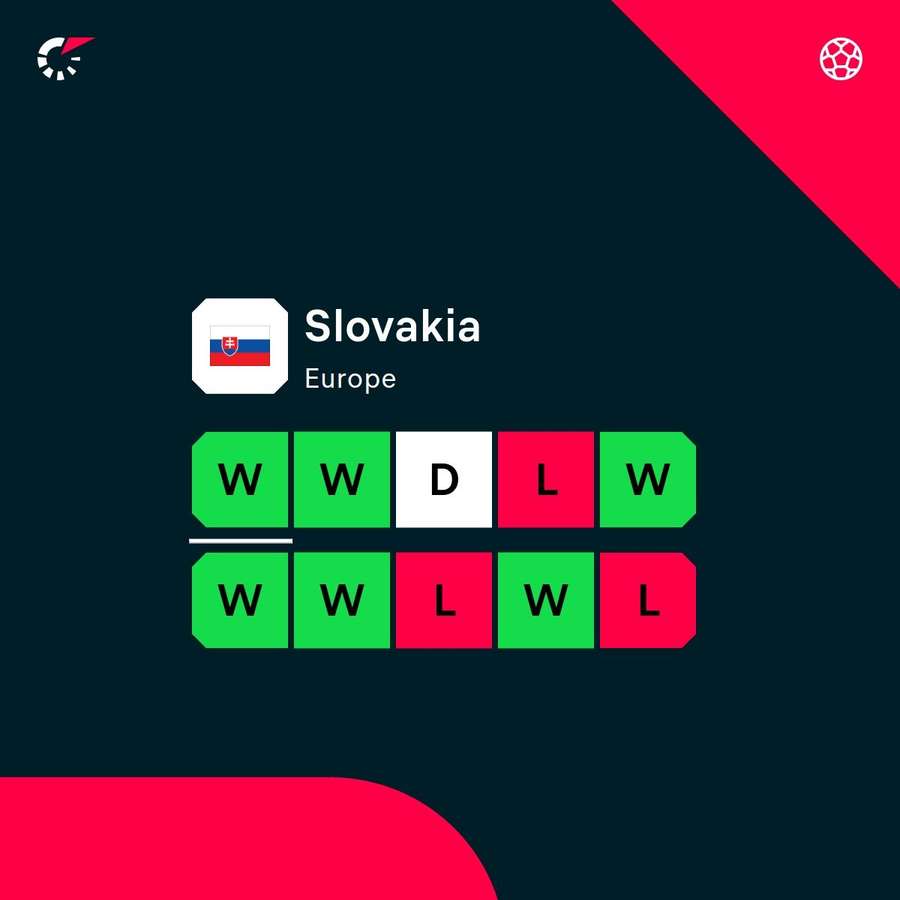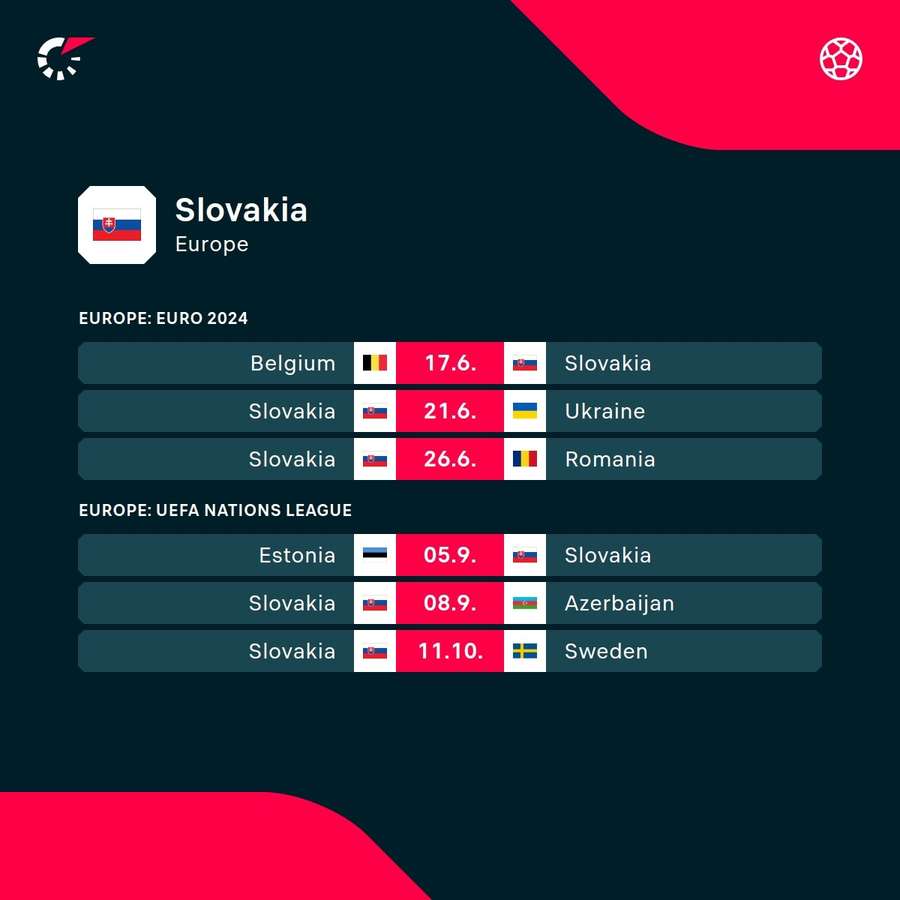EURO 2024 Preview: Slovakia face uphill task to qualify for knockouts

The Slovaks will rely primarily on a collective performance and will hope in the back of their minds that one of their attacking players will explode into life.
Road to the Finals
The division of points with Luxembourg at home at the start of the qualifiers was criticised and questions began to arise as to whether the choice of Italian coach Francesco Calzoni was the right one.
But then followed triumphs at home against Bosnia and Herzegovina, away to Iceland and the same in Liechtenstein. In September, the Slovaks gave a fighting performance, losing 1-0 to Portugal, but they followed that up by only tbeating minnows Liechtenstein by the narrowest of margins.
They were then beaten 3-2 at home by Portugal, but it was not so clear-cut, especially thanks to the excellent performance of goalkeeper Martin Dubravka.
Only three goals conceded with an expected (xG) statistic of 7.28 says it all.

However, Slovakia needed to win in the final two games to have a chance of reaching Germany, which they did. The 1-0 triumph in Luxembourg and especially the 4-2 home win over Iceland meant qualification for their third EUROs and the fourth final championship in the history of the independent republic. The victory in Bosnia and Herzegovina, with a changed squad, was a nice end to the qualification.
Star of the team - The collective
Poland has Robert Lewandowski, Ukraine has Artem Dovbyk, Hungary has Dominik Szoboszlai - Slovakia lacks a significant attacking calibre after the demise of Marek Hamsik, who recommended the current coach, which is also why it's hard to pick one name. Neither man dominates significantly and success is built on collective performance.
Weaknesses
If there's one thing fans from the Tatras fear, it's an injury to one man. Peter Pekarik has been a mainstay on the right side of the defense regularly since the summer of 2008. He has played 127 games for the national team, of which he has been in the starting lineup 122 times - a respectable number that confirms his importance.
The unpleasant news is that there is no orthodox replacement for him, so if Pekarik has a bad day, coach Francesco Calzona has to improvise on the right side... Let's venture a guess that opponents will be happy to use their left winger.
The second problem is the attacking line. A total of 17 goals scored in 10 qualifying matches is not a bad number, but then again, it is not exceptional either.
Lukas Haraslin had three goals, four players scored two goals each, but only Robert Mak was the striker or winger.
In the end he was not nominated because of (mis)communication with the head coach. He criticised him after he played only eight minutes in total in the March period, when the Slovaks played preparatory matches with Austria and Norway. That was after a long trip from Australia, where he and Sydney were fighting for a place in the A-League playoffs.
Aleksandar Cavric, for whom the Slovak Football Association arranged a Slovak passport, could have filled the gap, but there were complications in that direction as well.
The originally Serbian striker refused to come to the national team meeting in March after assessing that it would be better if he stayed in Japan and acclimatised in his new home - Kashima Antlers. The 30-year-old Cavric has subsequently missing in the May pre-tournament squad.
On the cusp of glory
For the third youngest player in the tournament, all eyes are on the future. Already at the age of 18, Leo Sauer has a market value of €5 million, which is a unique feat for a Slovakian.
Primarily a left winger, he has been with Dutch side Feyenoord for two years now, who scouted him from Zilina.
Last autumn he made his debut in the Champions League and Eredivisie, where he played 13 games, all as a substitute. In 274 minutes he scored two goals and added four assists, so he needs an average of 45.7 minutes to score a goal or make an assist. One can only hope that he continues to develop his talent.
Sauer could be said to be following in the footsteps of Tomas Suslov, who turned 22 on June 7th. Suslov is also a winger in terms of typology, he was named in the squad for EURO 2020, but he didn't fare so well after a terrific 2020/2021 season in Groningen, when he racked up two goals and five assists in 29 games (he was still only 18 years old at the time).

Probable line-up and tactics
No need to beat around the bush on this one. The proven 4-3-3 system, which the Slovaks used in the dress rehearsal, should be their stable formation at the Euros as well.
Dubravka in goal and in front of him the four from the right, Peter Pekarik, Denis Vavro, PSG's Milan Skriniar and David Hancko. Fans who have followed the left-footed defender over the last two years at Feyenoord may be surprised to see him on the left side in the national team.
However, as is the case with Pekarik, the Slovaks don't have a better orthodox option on the other side. Hanck, however, likes the position, having recorded a two goals and three assists in 10 games in qualifying. If there will be any change in the four-man defence, it will be first at right-back, where Norbert Gyomber from relegated Salernitana may replace Vavro from Copenhagen.
The captain of the team is Skriniar, who made his way from Inter Milan to Paris Saint-Germain last summer. During the autumn, he was clearly in the starting line-up, but after an injury in January he did not play for almost three months. When he was fit, he usually came off the bench or was only in the starting line-up in games where nothing was on the line. In the Champions League against Barcelona and Dortmund or in the French Cup final, he did not play at all.
The centre of the field will be formed, if we push it a bit too far, by the Italian trio. The Serie A winner from the 2022/2023 season, Stanislav Lobotka, will start the attacks and set the pace. Veteran and former AC Milan, Parma and Genoa player Juraj Kucka will add the necessary combativeness, pace and shooting bombs from distance.
Verona's Ondrej Duda, who has had more defensive duties in the fight to stay among Italy's elite, will be the highest of the bunch.
Francesco Calzona may replace him with Laszlo Benes from the 2. Bundesliga, where he plays for Hamburg. Alternatives for Lobotka and Kucka are Patrik Hrosovsky (Genk) or Matus Bero (Bochum).
The biggest question will be the composition of the attacking trio. Practically no one has a certain place in it and it will be determined on the basis of training and form from matches. In the friendly with Wales, the line-up of Schranz - Bozenik - Haraslin was formed. Several strikers had a great start to the season, but the spring didn't work out for them.
Lukas Haraslin scored 12 goals and assisted five in the Czech league, but since the beginning of March, his record was only three goals and assists. Finisher Robert Bozenik had eight goals in Liga Portugal, but has been silent since February 10th. Another number nine, David Duris, played on loan in Serie B in the spring, but only made two appearances for Ascoli and was relegated with the club.
However, given his form, we favour Tomas Suslov on the right wing, although especially against the Belgians, Pekarik will need more help from his attacking teammate. We predict that Bozenik could stay at the back, while Haraslin - the top scorer of the qualification - will start on the left.
Lubomir Tupta, youngster Sauer or David Strelec from Slovan Bratislava could also come off the bench.
Prediction
Yes, the qualification to the championship was already celebrated in Slovakia as a big thing, but in the qualifying group in which the team from the Tatras was, it was rather a duty. Considering that Group E is the easiest group Slovakia could have gotten at the final tournament from the point of view of the experts and ours, anything other than the round of 16 will be considered a disappointment.
Every goal will make the difference when advancing from third place, which we think will be the maximum. It will therefore be important to keep the Belgian attack at bay, then get at least a point against Ukraine and beat Romania. Getting out of the group could be a struggle.

